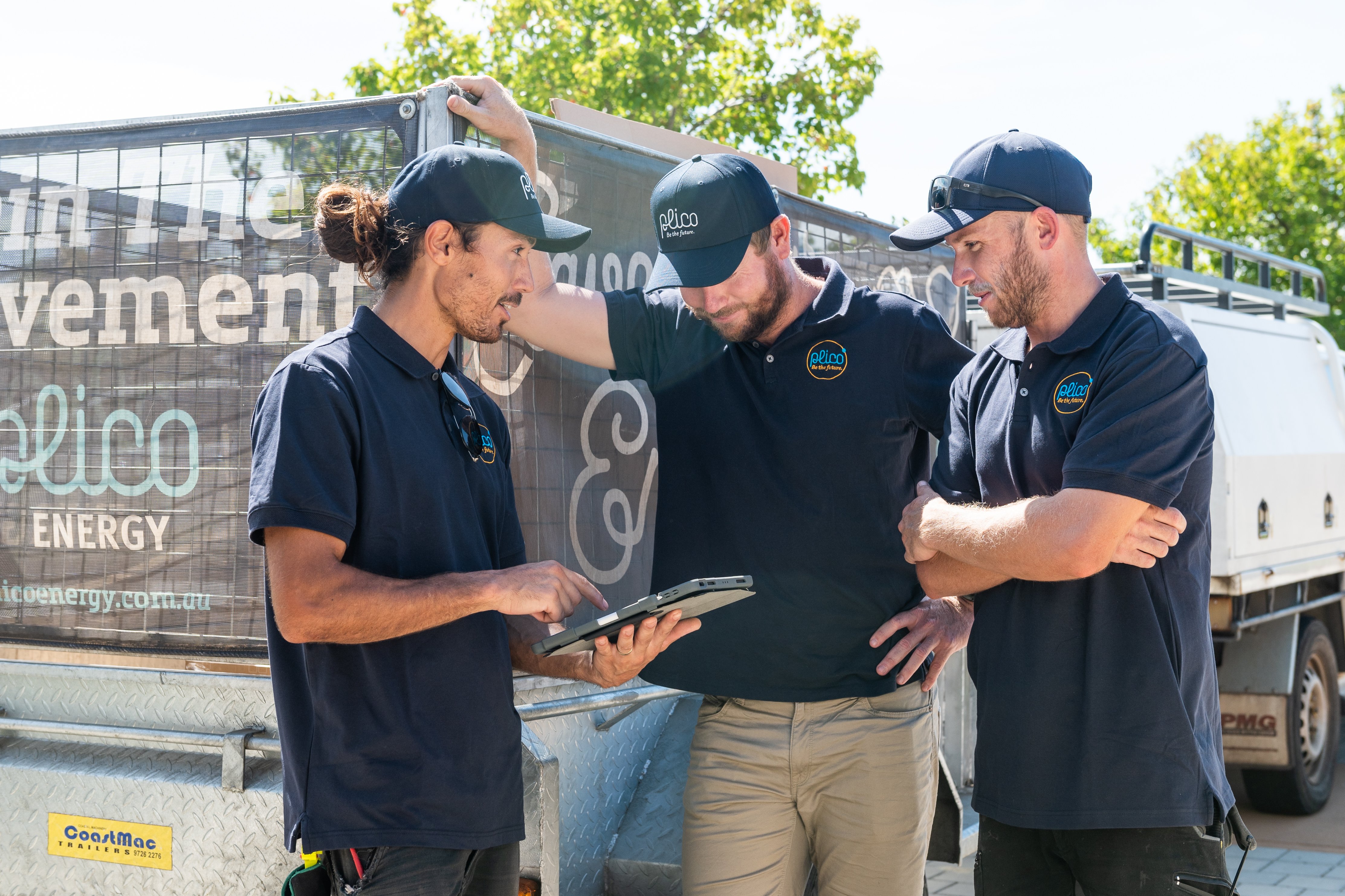A hybrid inverter is a combination of a solar panel inverter and a battery inverter. Inverters change direct current (DC) electricity from solar panels and batteries into alternating current (AC) electricity for household use. Solar panels and batteries have independent inverters, but hybrid inverters can work for both. They can also provide backup power during blackouts and reduce power loss through DC coupling.
How does a hybrid inverter work?
A hybrid inverter converts direct current (DC) electricity from your solar panels and batteries to alternating current (AC) electricity for household use. DC electricity flows in a single direction, whilst AC electricity constantly changes direction.
The solar panels in your system consist of photovoltaic (PV) cells. PV cells are made of multiple layers of materials called semiconductors. Semiconductors can be modified with electric fields and used for energy conversion. When sunlight is absorbed into PV cells, it creates an electric field. This electric field causes electrons to flow, resulting in DC electricity. This DC electricity flows to the hybrid inverter. The hybrid inverter reroutes DC electricity to fill the battery or converts it to AC electricity for the home.
DC electricity in the inverter is sent through a component called a transformer. This is an electrical conditioning device with two coils. Electricity enters through the primary coil. The direct current is forced to flow towards one coil more than the other repeatedly. This is done with semiconductor devices called transistors. These function as switches that rapidly turn the electrical flow on and off. This flow causes the transformer to process the electricity as having an alternating current. When the electricity exits through the second coil, it is AC rather than DC electricity. The hybrid inverter goes through the same process when the electricity comes from the solar battery.
A hybrid inverter is set up similarly to a string inverter. It has a central unit connected to the system’s solar panels. The DC electricity from a row of solar panels is all converted simultaneously. Some hybrid inverters have optimising units like a power optimiser. These are installed on individual panels. They condition the electricity, meaning they optimise the current for conversion. The optimising units allow for individual panel monitoring and optimisation.
Can a hybrid inverter work without a battery?
A hybrid inverter can function without a battery. A solar-only system continues to convert the electricity generated by solar panels. However, using a hybrid inverter for a system without a battery is not cost-effective. The main advantage of hybrid inverters is their ability to work as both solar and battery inverters. With a battery-free system, regular solar inverters are a cheaper choice.
Do I need a 3-phase hybrid inverter?
It’s best to have a 3-phase inverter if your home uses 3-phase power; however, it isn’t essential. Homes in Australia use single-phase or 3-phase power. 3-phase power supplies are more efficient and can transmit three times as much as single-phase power supplies. 3-phase power is suited to high-demand loads and appliances. You can see if your home has three-phase power by looking in your fuse box. If there are three main switches or fuse cartridges, you have 3-phase power. Due to 3-phase power providing a higher output, specialised inverters are preferred – these hybrid inverters have a higher capacity to accommodate increased loads. Aside from this, they function like single-phase hybrid inverters.
Under the microscope: Redback Smart Hybrid inverters
Redback Smart Hybrid inverters are one of our picks when it comes to hybrid inverters. Designed and tested for Australian conditions, Redback’s Smart Hybrid inverter range is industrious and durable, with a history of continued high performance. Because of this durability, the inverters can be installed inside or outside, depending on preference.
Redback Smart Hybrid inverters come with a pre-wired balance of system (BoS). BoS encompasses all the additional parts of a solar system apart from solar panels. Pre-wired BoS makes installation smoother and easier.
Redback Smart Hybrid inverters also feature seamless backup. During a power outage, they can start powering your main appliances within ten milliseconds. Redback hybrid inverters are available for both single-phase and 3-phase homes. Redback single-phase hybrid systems use a 5 kilovolt-ampere (kVA) solar inverter with battery storage between 4.8 and 28.4 kilowatt hours (kWh). Redback three-phase hybrid systems use a 10 kVA solar inverter with battery storage between 9.6 and 28.4 kWh.
The Redback Smart Hybrid inverter is part of our Energy Maker and Energy Booster solar + battery systems.
Under the microscope: Alpha ESS Hybrid Inverters
Plico also partners with Alpha ESS for both our battery-only and solar + battery systems. Alpha ESS is known for its adaptable equipment and software, hybrid inverters being no exception. Like Redback, an Alpha solar + battery system has a built-in hybrid inverter. When adding a battery, the Alpha ESS AC inverter has the capability of working with any existing solar setup.

Hybrid inverters vs normal inverters
A hybrid inverter has a few key differences from a normal inverter. All inverters work to convert DC electricity into AC electricity. For solar panels, solar inverters perform this conversion; for solar batteries, battery inverters do. However, hybrid inverters connect to both panels and a battery. The biggest advantage of a hybrid inverter is that certain types can function independently of the electrical grid. For safety reasons, most solar systems will stop operating when the grid is down, but not Plico’s solar + battery systems. With a Plico system, you can continue to power your home through a blackout, and even charge your battery if there’s excess solar.
What are the advantages of a hybrid inverter?
There are four primary advantages to using a hybrid inverter. These are backup power, minimising equipment in a system, smart features and DC coupling.
-
Hybrid inverters can provide backup power. During a blackout, regular inverters turn off for safety reasons. Hybrid inverters are connected to the battery, and many can continue to supply the household with power.
-
Hybrid inverters replace multiple inverters. Installing a hybrid inverter is easier and less expensive than installing both a solar inverter and a battery inverter.
-
Hybrid inverters can have smart features. These regulate your electrical system and provide useful information for monitoring.
-
Hybrid inverters can use DC coupling. This means they have the ability to feed DC electricity from solar panels directly into the battery. This reduces losses from repetitively converting the electricity.
What are the disadvantages of a hybrid inverter?
There are three main disadvantages to using a hybrid inverter. These are higher upfront costs, lower suitability to existing solar systems and varied backup settings.
-
Hybrid inverters cost more than regular solar inverters. They are not the most cost-effective choice for solar systems without batteries.
-
Hybrid inverters may not fit into existing solar setups. A solar system with a battery may have its own battery inverter. This removes the main benefit of a hybrid inverter. Choosing a hybrid inverter makes more sense for new systems.
-
Backup capabilities vary between hybrid inverters. The power output, the time for backup power to activate, and the utilisation of solar panels all depend on the model. These differences can make choosing a hybrid inverter confusing.
When should you use a hybrid inverter?
You should use a hybrid inverter if you need an inverter that can act as both a solar and battery inverter. By getting a hybrid inverter instead of individual solar and battery inverters, you’ll save money, experience easier installation, and – if you choose the right type – enjoy continued power supply during blackouts. You also increase the efficiency of your system by not converting your solar energy twice (through a solar inverter and a battery inverter) before it’s stored. If you have a solar battery in your system (which you should), you’ll require a battery inverter. By choosing a hybrid inverter, you save the cost of having to buy a battery inverter as well as a solar inverter.
Hybrid inverters vs off-grid inverters
A hybrid inverter is more versatile than an off-grid inverter. Off-grid inverters are connected to a battery and solar system but not the electricity grid. They are not capable of feeding power back into the grid. Hybrid inverters are connected to solar panels and batteries as well as the grid. This allows additional power to be drawn from the grid when the solar system’s power generation is insufficient. Off-grid inverters are cheaper than hybrid inverters, but just like when compared to solar and battery inverters, hybrids are in a class of their own for adaptability and functionality.
Solar equipment can take a bit of time to wrap your head around. More information can be found in our articles.
Learn all about:
- What size solar battery is right for you.
- How solar inverters and batteries work together.
- What appliances you can run with solar power.
- If you can charge an electric car with solar panels.
- How long solar batteries last.
- How to add a solar battery to your existing solar system.
Alternatively, you can chat with one of Plico’s switched-on team members by calling 1300 175 426 or filling out the form below. We’ll be able to provide you with information specific to your needs.
Have a question about solar + battery?

